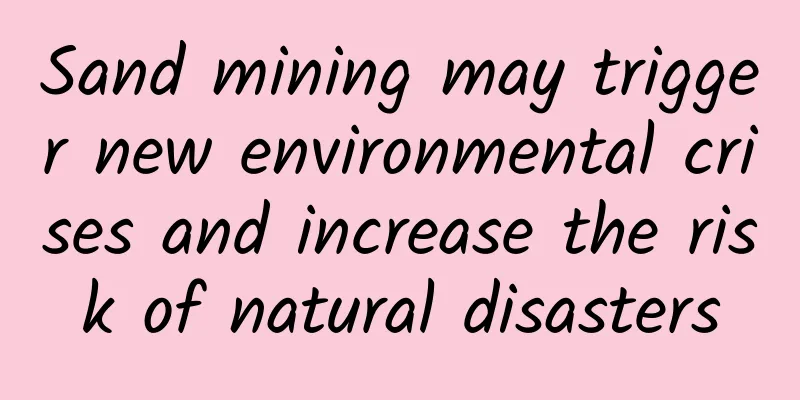Sand mining may trigger new environmental crises and increase the risk of natural disasters

Cities are, quite literally, built on sand. It is estimated that by 2050, 68% of the world's population will live in cities . But to house so many people, industrial sand or aggregate mining, which extracts sand and gravel from riverbeds, lakes, oceans and beaches for construction, is outpacing the rate at which these raw materials can be regenerated. This has a huge impact on the environment. The World Economic Forum discusses responses to this challenge in its new report, Transforming Industries for Nature, identifying five priority actions the cement and concrete industry should take to reduce its impact on nature. Environmental impacts of sand mining Image: United Nations Environment Programme How much sand has been mined? Sand is the second most mined natural resource in the world after water . According to the United Nations Environment Programme, sand mining has tripled in the past 20 years, with demand reaching 50 billion tons in 2019. In fact, the amount of sand used each year is enough to build a wall 27 meters high and 27 meters wide around the equator . But in many parts of the world, there is a lack of regulation on the extraction, sourcing, use and management of sand, which means we are consuming sand faster than it can be replaced by geological processes. The United Nations Environment Programme's "Sand Resources and Sustainable Development" report says that urgent action is needed, including a ban on coastal sand mining, to avoid a "sand crisis." Offshore dredging projects extract about 6 billion tons of sea sand each year , and a new data platform from the United Nations Environment Programme reveals that "this seriously affects biodiversity and the environment of coastal communities." Impact of sand mining on the environment Coastal features that may be affected by sand mining Image: United Nations Environment Programme The United Nations Environment Programme says that sand extraction from rivers and marine ecosystems “ can cause erosion, salinization of aquifers, loss of protection against storm surges, and impacts on biodiversity , which threaten livelihoods such as water supply, food production, fisheries and tourism, among other impacts.” In 2018, the World Wildlife Fund (WWF) warned that sand mining in river deltas such as the Yangtze and Mekong was increasing the risk of climate-related disasters by leaving coastal areas without sufficient sediment to protect against flooding. “Keeping the sand in the rivers is the best way to adapt to climate change,” Marc Goichot of the World Wildlife Fund told the Thomson Reuters Foundation. “If a river delta has enough sediment, it will naturally accumulate above sea level.” How to avoid the sand crisis? While the government is increasing pressure to regulate sand mining, more efforts are needed to find alternatives to construction sand and solve the ongoing housing crisis around the world. For example, Singapore is using recycled glass waste instead of sand in its 3D printing concrete technology. The UNEP report outlines 10 recommendations to avoid a sand crisis that balance the needs of the construction industry and the environment: The United Nations Environment Programme says that in order to manage sand and gravel resources "rationally, responsibly and sustainably", sand and gravel must be formally identified as a "strategic resource for all levels of government and society" and ecosystems degraded by sand mining must be restored. Author of this article: Kate Whiting, Senior Writer, Forum Agenda Madeleine North, Forum Programme Writer This article originally appeared on the World Economic Forum's Agenda blog |
>>: TV is also crazy: Konka TV Slim challenges 10 extreme tortures
Recommend
Operational planning for a product: the focus is on ideas, not writing plans
To put it simply, if you are given a product, how...
After investing tens of millions, you can understand the advertising promotion bidding mechanism here!
On a media platform, there will be tens of thousa...
LeTV Super TV MAX70 two-week experience
Advantages: 1. Large and clear screen; 2. Smooth o...
How do Weibo operators increase followers through lucky draws? Follow these 6 steps!
"Give me a fulcrum and I can move the earth....
2024 New Energy Vehicle Q3 Quarterly Report: Traditional Automakers’ Car Computers Perform Well
2024 has quietly come to an end, and the new ener...
Hprose 2.0.0 for HTML5 released, high-performance cross-language RPC
[[145117]] Hprose 2.0.0 for HTML5 is finally rele...
Beijing "Wild Hunting" Guide! How many of these wild delicacies have you tried?
Beijing is located in the northern part of the No...
How harmful is it to wear headphones for a long time? Teach you how to use headphones correctly
Listening to music, watching TV shows, playing ga...
From top configuration to scrapped, what did Yuan Shao go through?
Mixed Knowledge Specially designed to cure confus...
The reason why the "face plate" has become bigger has been found! (It's not because of obesity)
In daily life, have you ever felt snapping or dis...
It’s only the 28th, how come it’s already the end of the month?
Those who were born on February 29th must have ha...
The best ways to exercise after 40 are revealed. It turns out that these are the types! Many people exercise incorrectly!
What kind of sports should you choose after you t...
Apple's App Store search rules have become dramatically more equal
Last week, the news that Apple CEO Tim Cook came ...
iOS 14.5 no longer defaults to female voice, English Siri adds two new voices
Apple released the iOS 14.5 beta 6 beta system. F...
Fudan professor's new research findings: The more expensive the mobile phone, the more expensive it is to take a taxi
"Work overtime until late at night, open the...









